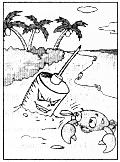题目内容
9.Getting kids to share their toys is a never-ending battle,and forcing them to do so never seems to help.New research suggests that allowing children to make a choice to sacrifice their own toys in order to share with someone else makes them share more in the future.The new findings are published in Psychological Science.These experiments were conducted by psychological scientists,Nadia Chernyak and Tamar Kushnir of Cornell University.They found that sharing things with others when they are given a difficult choice leads children to think of themselves as people who like to share.It also makes them more likely to act in a pro-social (亲社会的)manner in the future.
Previous research has explained why rewarding children for sharing can backfire.Children come to think of themselves as people who don't like to share since they had to be rewarded for doing so.Because they don't view themselves as"sharers"they are less likely to share in the future.
Chernyak and Kushnir were interested in finding out whether freely chosen sacrifice might have the opposite effect on kids'willingness to share.To test this,the researchers introduced five-year-old children to Doggie,a sad puppet.Some of the children were given a difficult choice:Share a precious sticker with Doggie,or keep it for themselves.Other children were given an easy choice between sharing and putting the sticker away,while children in a third group were required by the researcher to share.
Later on,all the children were introduced to Ellie,another sad puppet.They were given the option of how many stickers to share (up to three).The kids who earlier made the difficult choice to help Doggie shared more stickers with Ellie.The children who were initially faced with an easy choice or who were required to give their sticker to Doggie,on the other hand,shared fewer stickers with Ellie.Therefore,children did not benefit from simply giving something up,but rather from willingly choosing to give something up of value.
"You might imagine that making difficult,costly choices is taxing for young children or even that once children share,they don't feel the need to do so again,"Chernyak says."But this wasn't the case:once children made a difficult decision to give up something for someone else,they were more generous,not less,later on."Chernyak concludes.
74.Dhelps children to share more in the future.
A.Rewarding children for sharing stickers
B.Requiring children to share their favorite toys
C.Allowing children to share what they don't need
D.Encouraging children to share precious things willingly
75.The underlined word"backfire"meansD.
A.serve as a push B.have an opposite effect
C.cause anger D.avoid taking things back
76.Those who were required to share give fewer stickers to Ellie becauseA.
A.it's not their own choice B.they regret what they did
C.Ellie is not as sad as Doggie D.they like to share with a real person
77.We can conclude from the passage thatC
A.parents will never find a way to get children to share toys
B.a gift should be given to make up for children's sacrifice
C.making difficult choices may influence sharing behavior
D.children pretend to be generous when they are being observed.
分析 文章介绍了儿童分享事物的心理科学.有研究表明孩子做出艰难选择会对他们的分享行为有影响,他们可能会变的慷概.
解答 74.答案D 推理判断题:根据文章第一段中"New research suggests that allowing children to make a choice to sacrifice their own toys in order to share with someone else makes them share more in the future."新研究表明,让孩子选择牺牲自己的玩具与别人分享可让他们在未来分享更多东西.由此可知培养孩子分享意愿对孩子将来分享更多东西是有帮助的.故选D.
75.答案 D 推理判断题:backfire是"产生出乎意料及事与愿违的结果"的意思.A.serve as a push作为一种推动;B.have an opposite effect有反作用;C.cause anger导致某人轻微愤怒;D.Avoid taking things back避免拿回东西.只有B想符合划线词义.故选B.
75.答案A 细节理解题:根据第五段中"The children who were initially faced with an easy choice or who were required to give their sticker to Doggie,on the other hand,shared fewer stickers with Ellie"最初孩子们面临着一个简单的选择或着被要求把他们的贴纸给小狗,要么与艾莉分享更少的贴纸.由此可知这是被要求的.故选A.
76.答案 C 主旨大意题:根据文章内容可知文章表明孩子做出艰难选择会对他们的分享行为有影响,他们可能会变的慷概.故选C.
点评 1、要想做好科普英语阅读理解题,同学们就要注意平时多读科普知识类文章,学习科普知识,积累常见的科普词汇,从根本上提高科普英语的阅读能力.
2、要熟悉科普类文章的结构特点.科普类文章一般由标题(Head line),导语(Introduction),背景(Back ground),主体(Main body)和结尾(End)五部分构成.标题是文章中心思想高度而又精辟的概括,但根据历年的高考情况来看,这类阅读理解材料一般不给标题,而要同学们选择标题.导语一般位于整篇文章的首段.背景交待一个事实的起因.主体则对导语概括的事实进行详细叙述,这一部分命题往往最多,因此,阅读时,同学们要把这部分作为重点.结尾往往也是中心思想的概括,并与导语相呼应,命题者常在此要设计一道推理判断题.
3、在进行推理判断时,同学们一定要以阅读材料所提供的科学事实为依据,同时所得出的结论还应符合基本的科普常识.

| A. | them | B. | whom | C. | who | D. | which |
| A. | once | B. | after | C. | unless | D. | while |
| A. | anything,everything | B. | nothing,everything | ||
| C. | everything,anything | D. | none,everything |
 A Terrible Surprise at the Beach
A Terrible Surprise at the Beach 